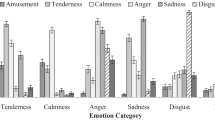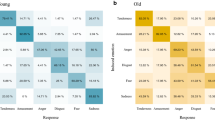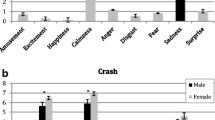Abstract
In affective computing an accurate emotion recognition process requires a reliable emotion elicitation method. One of the arising questions while inducing emotions for computer-based emotional applications is age group differences. In the present study, we investigate the effect of emotion elicitation on various age groups. Emotion elicitation was conducted using standardized movie clips representing five basic emotions: amusement, sadness, anger, disgust and fear. Each emotion was elicited by three different clips. The different clips are individually rated and the subjective choice of the most relevant clip is analyzed. The results show the influence of age on film-clip choice, the correlation between age and valence/arousal rating for the chosen clips and the differences in valence and arousal ratings in the different age groups.
You have full access to this open access chapter, Download conference paper PDF
Similar content being viewed by others
Keywords
- Emotion elicitation
- Affective computing
- Emotion recognition
- Human-computer interaction
- Film clips
- Age difference
1 Introduction
Affective computing aims to numerically process and identify the emotional state of humans. In Human-Computer Interaction (HCI), a correct interpretation of emotions is indispensable to allow computers –such as “companion” systems [1] – to predict the users’ needs and wishes and to appropriately adapt their behavior or respond to the current emotional states of a person. An accurate emotion recognition process requires in addition a reliable emotion elicitation method to train the classification.
For various HCI applications, how emotions can be elicited is still an essential issue in affective computing. The induction of emotions in a standardized manner can be realized with the help of specific stimuli. External stimuli can be standardized pictures, for instance from the International Affective Pictures System (IAPS) [2–4], music material [5–7] or film clips [8–10], whereas internal stimuli relate to autobiographical events of the individual subject [11] or imagination methods [12]. Further, these stimuli can be either presented in a passive viewing manner (pictures or film clips) or they can be incorporated as part of the human-computer interaction.
Emotional response to specific stimuli is characterized by various psychophysiological and behavioral patterns [13]. Their measurability also depends on the individual subjects. One of the arising questions while inducing emotions for computer-based emotional applications is the influence of specific individual variables such as gender, age or personality. Individual differences in the perception of various emotional stimuli play an essential role in the further analysis and processing of emotion recognition in affective computing studies and have been shown to have an impact on the classification accuracies [14]. Interestingly, and to the best of the authors’ knowledge, standardized material has not been checked for the influence of age.
In the present study, we investigate the effect of emotion elicitation using movie clips on various age groups. The choice of a specific clip as well as its rating in terms of valence and arousal is analyzed and the results are presented for three different age groups.
2 Materials and Methods
An individualized emotion setting for Human-Computer Interactions has been developed to -amongst others- induce various emotional states in subjects. The emotion elicitation was conducted using standardized movie clips from Hewig et al. [8]. Compared to other elicitation methods, induction based on film clips presents some advantages being a multichannel method, dynamic rather than static and does not need imagination and suggestibility of the subjects. Five basic emotions are implemented and were induced within the setting. These include: amusement, sadness, anger, disgust and fear. Three clips of each of these basic emotions were selected and presented as one emotion presentation. After every basic emotion induction (a set of 3 clips), the subjects were asked to choose and rate the clip which evoked the strongest emotion. The ratings (1–9) are given for valence, arousal and for the intensity of the basic emotion itself. A total of 94 subjects participated in the experiment, recruited from the following age groups: (1) 18–35 years (n = 35; 16 men, 19 women), (2) 36–50 years (n = 31; 13 men, 18 women), and (3) 51–65 years (n = 28; 15 men, 13 women). Recruitment was performed through notices posted at the university for the 18- to 35-years-old age group and through the press for the 36- to 65-years-old age groups. All the subjects were included in the final analysis.
3 Results and Discussion
To study the effect of emotion induction on age differences, the individual feedback of the subjects regarding the film clip choice evoking the strongest emotion and the corresponding rating for valence and arousal is analyzed. In the following, the analysis results are presented showing the influence of age on film clip choice, the correlation between age and valence/arousal rating for the chosen clips and the differences in valence and arousal ratings in the different age groups.
3.1 Effect of Age on Film Clip Choice
The distributions of the clip choices for age group 1, age group 2 and age group 3 are illustrated in Figs. 1, 2 and 3, respectively. For the whole sample group (N = 94), our results show similar clip choices as suggested by Hewig et al. [8] for all 5 emotions (Fig. 4). The choice results show also that with exception to amusement in age group 1 and in age group 3, the clip choice preferences in the different groups are the same compared to the whole sample. The corresponding clip choice distribution is however different.
Table 1 shows the Cochrans’s Q test analysis regarding the significant differences among the three film clips in the total sample and in the three age groups. It shows that with exception to amusement and disgust in age group 3, the clip choice preferences in the three age groups and in the whole sample are significant.
3.2 Correlation Between Age and Valence/Arousal Rating
Rating results for the valence and arousal of the chosen clips show also variations between the different age groups. Corresponding correlation analysis on the effect of age on the rating is presented below.
Correlation Between Age and Valence Rating:
Spearman correlation analysis between age and valence rating is presented in Table 2. The results show that there are significant positive relationships between age and valence rating elicited by amusement and sadness film clips. This means that the older the person is, the higher the valence rating they give for amusement and sadness.
Correlation Between Age and Arousal Rating:
Spearman correlation analysis between age and arousal rating is presented in Table 3. The results show that there are significant positive relationships between age and arousal rating elicited by all five emotional film clips. This means that the older the person is, the higher the arousal rating they give for all five emotions.
3.3 Influence of Age Groups on Valence and Arousal Rating
Table 4 illustrates the rating values (1–9) given for valence and arousal regarding the five emotional states of the chosen clips. The results are shown for the whole sample (N = 94) and for the three different age groups. Except the valence rating of disgust, the mean values given by group 1 are always lower, while those given by group 3 are always higher compared to the mean rating values of the whole sample.
All groups rated amusement with the highest mean valence. The lowest mean valence rating was given for disgust by both group 2 and group 3, while group 1 rated the lowest mean valence for anger followed by fear.
Further, all groups rated sadness with the lowest mean arousal. More differences are found in the highest mean arousal ratings, being: amusement in group 1, fear in group 2 and anger in group 3. In the whole sample N = 94, the highest arousal rating was given for fear, thus similar to the rating of group 2.
4 Conclusion
In this paper, we present the first results on the effect of emotion elicitation within various age groups. The subjective rating results of the film clips show that the choice preferences within the whole sample are similar to the original results obtained by Hewig et al. [8]. Although the distribution of the film clip choices between the different age groups is different, the film choice preferences were found to be the same. This allows adapting those clips of Hewig et al. –originally conducted on a student sample of 38 participants (21 females, 17 males; mean age 22.3 years, range 19 ± 39 years)– for all age groups for the induction of the five emotions (amusement, sadness, anger, disgust, fear).
Our correlation analysis shows significant positive relationships between age and valence rating elicited by amusement and sadness film clips and between age and arousal rating elicited by all five emotions. Also, descriptive rating analysis for the valence and arousal of the chosen clips is conducted and shows variations between the different groups.
Further statistical analysis on the correlation of arousal and valence ratings in the different age groups as well as the analysis of emotion intensity rating is being currently processed.
References
Wendemuth, A., Biundo, S.: A companion technology for cognitive technical systems. In: Esposito, A., Esposito, A.M., Vinciarelli, A., Hoffmann, R., Müller, V.C. (eds.) COST 2102. LNCS, vol. 7403, pp. 89–103. Springer, Heidelberg (2012)
Lang, P., Greenwald, M., Bradley, M., Hamm, A.: Looking at pictures: affective, facial, visceral, and behavioral reactions. Psychophysiology 30(3), 261–273 (1993)
Bradley, M., Lang, P.: The international affective picture system (IAPS) in the study of emotion and attention. In: Coan, J.A., Allen, J.J.B. (eds.) Handbook of Emotion Elicitation and Assessment, vol. 29. Oxford University Press, Oxford (2007)
Frantzidis, C., Bratsas, C., Klados, M., Konstantinidis, E., Lithari, C., Vivas, A., Papadelis, C., Kaldoudi, E., Pappas, C., Bamidis, P.: On the classification of emotional biosignals evoked while viewing affective pictures: an integrated data-mining-based approach for healthcare applications. IEEE Trans. Inf. Technol. Biomed. 14(2), 309–318 (2010)
Daly, I., Malik, A., Hwang, F., Roesch, E., Weaver, J., Kirke, A., Williams, D., Miranda, E., Nasuto, S.J.: Neural correlates of emotional responses to music: an EEG study. Neurosci. Lett. 573, 52–57 (2014)
Kim, J., André, E.: Emotion recognition based on physiological changes in music listening. IEEE Trans. Pattern Anal. Mach. Intell. 30(12), 2067–2083 (2008)
Lundqvist, L.O., Carlsson, F., Hilmersson, P., Juslin, P.: Emotional responses to music: experience, expression, and physiology. Psychol. Music (2008)
Hewig, J., Hagemann, D., Seifert, J., Gollwitzer, M., Naumann, E., Bartussek, D.: A revised film set for the induction of basic emotions. Cogn. Emot. 19(7), 1095–1109 (2005)
Gross, J., Levenson, R.: Emotion elicitation using films. Cogn. Emot. 9(1), 87–108 (1995)
Kreibig, S., Wilhelm, F., Roth, W., Gross, J.: Cardiovascular, electrodermal, and respiratory response patterns to fear and sadness inducing films. Psychophysiology 44(5), 787–806 (2007)
Mills, C., D’Mello, S.: On the validity of the autobiographical emotional memory task for emotion induction. PLoS ONE 9(4), e95837 (2014)
Kothe, C., Makeig, S., Onton, J.: Emotion recognition from EEG during self-paced emotional imagery. In: Humaine Association Conference IEEE Affective Computing and Intelligent Interaction (ACII), pp. 855–858 (2013)
Kolodyazhniy, V., Kreibig, S., Gross, J., Roth, W., Wilhelm, F.: An affective computing approach to physiological emotion specificity: toward subject-independent and stimulus-independent classification of film-induced emotions. Psychophysiology 48, 908–922 (2011)
Rukavina, S., Gruss, S., Tan, J.-W., Hrabal, D., Walter, S., Traue, H.C., Jerg-Bretzke, L.: The impact of gender and sexual hormones on automated psychobiological emotion classification. In: Kurosu, M. (ed.) HCII/HCI 2013, Part V. LNCS, vol. 8008, pp. 474–482. Springer, Heidelberg (2013)
Acknowledgements
This research was supported by grants from the Transregional Collaborative Research Center SFB/TRR 62 Companion Technology for Cognitive Technical Systems funded by the German Research Foundation (DFG) and a doctoral scholarship funded by the China Scholarship Council (CSC) for Xueyao Ma.
Author information
Authors and Affiliations
Corresponding author
Editor information
Editors and Affiliations
Rights and permissions
Copyright information
© 2015 Springer International Publishing Switzerland
About this paper
Cite this paper
Hazer, D., Ma, X., Rukavina, S., Gruss, S., Walter, S., Traue, H.C. (2015). Emotion Elicitation Using Film Clips: Effect of Age Groups on Movie Choice and Emotion Rating. In: Stephanidis, C. (eds) HCI International 2015 - Posters’ Extended Abstracts. HCI 2015. Communications in Computer and Information Science, vol 528. Springer, Cham. https://doi.org/10.1007/978-3-319-21380-4_20
Download citation
DOI: https://doi.org/10.1007/978-3-319-21380-4_20
Publisher Name: Springer, Cham
Print ISBN: 978-3-319-21379-8
Online ISBN: 978-3-319-21380-4
eBook Packages: Computer ScienceComputer Science (R0)












